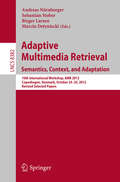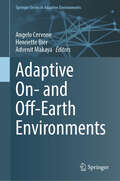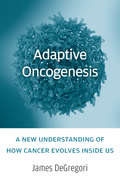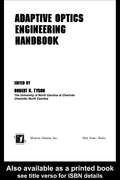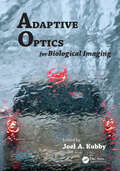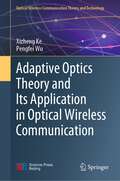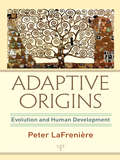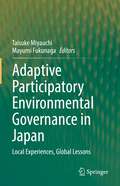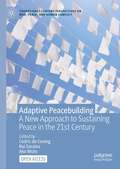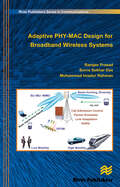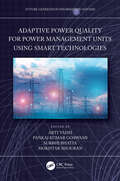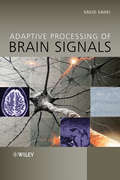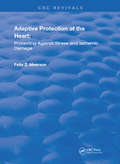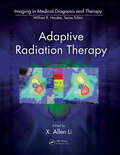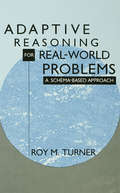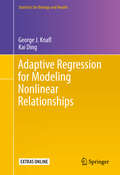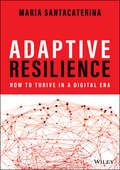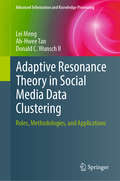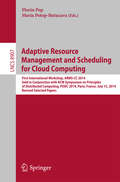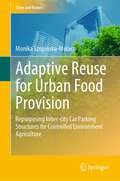- Table View
- List View
Adaptive Multimedia Retrieval: 10th International Workshop, AMR 2012, Copenhagen, Denmark, October 24-25, 2012, Revised Selected Papers (Lecture Notes in Computer Science #8382)
by Birger Larsen Andreas Nürnberger Sebastian Stober Marcin DetynieckiThis book constitutes the thoroughly refereed post-conference proceedings of the 10th International Conference on Adaptive Multimedia Retrieval, AMR 2012, held in Copenhagen, Denmark, in October 2012. The 17 revised full papers presented were carefully reviewed and selected from numerous submissions. The papers cover topics of state of the art contributions, features and classification, location context, language and semantics, music retrieval, and adaption and HCI.
Adaptive On- and Off-Earth Environments (Springer Series in Adaptive Environments)
by Henriette Bier Angelo Cervone Advenit MakayaThis volume investigates the challenges and opportunities for designing, manufacturing and operating off-Earth infrastructures in order to establish adaptive human habitats. The adaptive aspects are considered with respect to the development of adequate infrastructures designed to support human activities. Given the limitations in bringing materials from Earth, utilisation of in-situ resources is crucial for establishing and maintaining these infrastructures.Adaptive on-and off-Earth Environments focuses, among other aspects, on the design, production, and operation processes required to build and maintain such off-Earth infrastructures, while heavily relying on In-Situ Resource Utilisation (ISRU). Such design, production, and operation processes integrate cyber-physical approaches developed and tested on Earth. The challenge is to adapt on-Earth approaches to off-Earth applications aiming at technology advancement and ultimately transfer from on- to off-Earth research. Thischallenge is addressed with contributions from various disciplines ranging from power generation to architecture, construction, and materials engineering involving ISRU for manufacturing processes. All chapters, related to these disciplines, are structured with an emphasis on computing and adaptivity of on-Earth technology to off-Earth applications and vice versa to serve society at large.
Adaptive Oncogenesis: A New Understanding of How Cancer Evolves inside Us
by James DeGregori DeGregoriPopular understanding holds that genetic changes create cancer. James DeGregori uses evolutionary principles to propose a new way of thinking about cancer’s occurrence. Cancer is as much a disease of evolution as it is of mutation, one in which mutated cells outcompete healthy cells in the ecosystem of the body’s tissues. His theory ties cancer’s progression, or lack thereof, to evolved strategies to maximize reproductive success. Through natural selection, humans evolved genetic programs to maintain bodily health for as long as necessary to increase the odds of passing on our genes—but not much longer. These mechanisms engender a tissue environment that favors normal stem cells over precancerous ones. Healthy tissues thwart cancer cells’ ability to outcompete their precancerous rivals. But as our tissues age or accumulate damage from exposures such as smoking, normal stem cells find themselves less optimized to their ecosystem. Cancer-causing mutations can now help cells adapt to these altered tissue environments, and thus outcompete normal cells. Just as changes in a species’ habitat favor the evolution of new species, changes in tissue environments favor the growth of cancerous cells. DeGregori’s perspective goes far in explaining who gets cancer, when it appears, and why. While we cannot avoid mutations, it may be possible to sustain our tissues’ natural and effective system of defense, even in the face of aging or harmful exposures. For those interested in learning how cancers arise within the human body, the insights in Adaptive Oncogenesis offer a compelling perspective.
Adaptive Optics Engineering Handbook
by Robert TysonThis handbook supplies analytical tools for the design and development of adaptive optics systems to enhance their ability to adjust for atmospheric turbulence, optical fabrication errors, thermally induced distortions, and laser device aberrations. It provides recommendations for selecting, testing and installing a wavefront compensation system.
Adaptive Optics for Biological Imaging
by Joel A. KubbyAdaptive Optics for Biological Imaging brings together groundbreaking research on the use of adaptive optics for biological imaging. The book builds on prior work in astronomy and vision science. Featuring contributions by leaders in this emerging field, it takes an interdisciplinary approach that makes the subject accessible to nonspecialists who
Adaptive Optics Theory and Its Application in Optical Wireless Communication (Optical Wireless Communication Theory and Technology)
by Xizheng Ke Pengfei WuThis book introduces in detail the theory of adaptive optics and its correction technology for light wave distortion in wireless optical communication. It discusses the adaptive control algorithm of wavefront distortion, proportional+integral control algorithm and iterative control algorithm, and double fuzzy adaptive PID control algorithm. It also covers the SPGD algorithm of adaptive optics correction, deformable mirrors eigenmode method of wavefront aberration correction, vortex beam wavefront detecting wavefront aberration correction, liquid crystal spatial light modulator wavefront correction, different wavelengths of Gaussian beam transmission wavefront differences in the atmospheric turbulence and correction and with wavefront tilt correction adaptive optics wavefront aberration correction. Various distortion correction methods are verified by experiments and the experimental results are analyzed. This book is suitable for engineering and technical personnel engaged in wireless optical communication, college teachers, graduate students and senior undergraduate students.
Adaptive Origins: Evolution and Human Development
by Peter LaFrenièreIn this text, students are invited to rethink psychology by grounding it in the natural sciences with the understanding that evolutionary and developmental processes work together with culture to solve problems of human adaptation. These processes are cast as interdependent: Development cannot be understood except in the light of evolutionary theory, and the best proof of evolution is the fact of development. For students of evolutionary psychology, all the central topics -- such as evolved mental modules for theory of mind or language -- require an understanding of the developmental processes that lead to their expression. Genes, as important as they are, are never the whole story. The role of biological factors is explored in chapters outlining evolution, development, genetics, human origins, hormones and the brain. Then, the integrative value of this evolutionary/developmental vision in understanding key topics in psychology is illustrated by applying it to traditional area of inquiry including infancy and attachment, emotions and their expression, social relations with peers, cognitive and language development, sex differences, courtship and mating, violence and aggression, and cooperation and competition.
Adaptive Participatory Environmental Governance in Japan: Local Experiences, Global Lessons
by Taisuke Miyauchi Mayumi FukunagaThis book contributes to the theoretical and practitioner literature in environmental governance and sustainability of natural resources by linking case studies of the roles of narratives to the three key practices in local environmental governance: socio-political legitimacy in participation; collaboratively creating stakeholder-ness, and cultivating social and ecological capabilities. It provides numerous theoretical insights on legitimacy, adaptability, narratives, process-oriented collaborative planning, and among others, using in-depth case studies from historical and contemporary environmental issues including conservation, wildlife management, nuclear and tsunami disasters, and thus community risk, recovery, and resiliency. The authors are all practitioner-oriented scientists and scholars who are involved as local stakeholders in these practices. The chapters highlight their action and participatory-action research that adds deeper insights and analyses to successes, failures, and struggles in how narratives contribute to these three dimensions of effective environmental governance. It also shows how stakeholders’ kinds of expertise, in a historical context, help to bridge expert and citizen legitimacy, as well as spatial and jurisdictional governance structures across scales of socio-political governanceOf particular interest, both within Japan and beyond, the book shares with readers how to design and manage practical governance methods with narratives. The detailed design methods include co-imagination of historical and current SESs, designing processes for collaborative productions of knowledge and perceptions, legitimacy and stakeholder-ness, contextualization of contested experiences among actors, and the creation of evaluation standards of what is effective and effective local environmental governance.The case studies and their findings reflect particular local contexts in Japan, but our experiences of multiple natural disasters, high economic growth and development, pollutions, the nuclear power plant accident, and rapidly aging society provide shared contexts of realities and provisional insights to other societies, especially to Asian societies.
Adaptive Peacebuilding: A New Approach to Sustaining Peace in the 21st Century (Twenty-first Century Perspectives on War, Peace, and Human Conflict)
by Cedric De Coning Rui Saraiva Ako MutoThis open access book responds to the urgent need to improve how we prevent and resolve conflict. It introduces Adaptive Peacebuilding through evidence-based research from eight case studies across Africa, Asia, the Middle East, and Latin America. It also considers how China and Japan view and practice peacebuilding. The book focuses on how peacebuilders design, implement and evaluate programs to sustain peace, how interactions between external and local actors have facilitated or hindered peacemaking, and how adaptation to complexity and uncertainty occurred in each case study.
Adaptive PHY-MAC Design for Broadband Wireless Systems (River Publishers Series In Communications Ser.)
by Ramjee Prasad Suvra Sekhar Das Muhammad Imadur RahmanThe next generation mobile communication networks (4G) have the challenging target of The next generation mobile communication networks (4G) have the challenging target of providing a peak data rate of 1 Gigabit per second local area and 100 Megabit per second wide area. The ability to offer such high data rates in 100MHz bandwidth requires overall a very high spectral efficiency, and hence the need for multi-antenna techniques (MIMO) with spatial multiplexing, fast dynamic link adaptation and packet scheduling, wideband access techniques, and most likely non-contention based spectrum sharing among multiple operators. Many of these required technology components and techniques are well researched and established. Adaptive PHY-MAC Design for Broadband Wireless Systems explains how one can integrate and optimise their use in providing the target cell data rates with high availability. The authors address the ability to cope with interference and enhanced physical layer processing, and simultaneously, the multifaceted system level design. Focus is also on the selection of technology components and techniques, which leads to the highest spectral efficiency and peak data rate availability with reasonable Quality of Service (QoS) support, such as improved outage scenario, reduced delay, guaranteed bit rate, etc.In short, this book will answer questions such as, how individual techniques relate to each other, how can we benefit the gains by suitable combinations of different technologies and how to choose different technological solutions in different scenarios, etc.The next generation mobile communication networks (4G) have the challenging target of The next generation mobile communication networks (4G) have the challenging target of providing a peak data rate of 1 Gigabit per second local area and 100 Megabit per second wide area.
Adaptive Platform Trials: The Clinical Trial of the Future?
by Ariel D. Stern Sarah MehtaIn July 2017, Dr. Brian M. Alexander, president and CEO of the AGILE Research Foundation, was preparing to launch a new type of clinical trial—an adaptive platform trial—to study potential therapies for glioblastoma (GBM), an aggressive form of brain cancer. <p><p> Alexander believed that the standard way in which new cancer drugs were tested—the traditional randomized controlled trial (RCT)—was limited in many ways. While statistically rigorous and still considered the “gold standard” in clinical research, traditional RCTs were time-consuming, costly, and limited to testing just one new drug at a time. Adaptive platform trials, by contrast, facilitated simultaneously studying multiple therapies for a given disease and promised a number of efficiency improvements. They also used statistical techniques to allow more patients access to promising therapies. As such, they had the potential to fundamentally change the clinical research process, making clinical trials for new cancer drugs more efficient, more accessible to patients, and more ambitious in scope. <p> For the past three years, Alexander had been working closely with a group of like-minded oncologists, statisticians, and clinical trial strategists to design an adaptive platform trial for GBM in the hopes of identifying effective therapies more quickly. By mid-2017, Alexander and his colleagues had completed a master protocol for the trial. But now the research team faced several design and operational challenges as they prepared for the trial’s launch. Most pressing, how should Alexander and his colleagues finance the trial?
Adaptive Platform Trials: The Clinical Trial of the Future?
by Ariel D. Stern Sarah MehtaIn July 2017, Dr. Brian M. Alexander, president and CEO of the AGILE Research Foundation, was preparing to launch a new type of clinical trial-an adaptive platform trial-to study potential therapies for glioblastoma (GBM), an aggressive form of brain cancer. Alexander believed that the standard way in which new cancer drugs were tested-the traditional randomized controlled trial (RCT)-was limited in many ways. While statistically rigorous and still considered the "gold standard" in clinical research, traditional RCTs were time-consuming, costly, and limited to testing just one new drug at a time. Adaptive platform trials, by contrast, facilitated simultaneously studying multiple therapies for a given disease and promised a number of efficiency improvements. They also used statistical techniques to allow more patients to access promising therapies. As such, they had the potential to fundamentally change the clinical research process, making clinical trials for new cancer drugs more efficient, more accessible to patients, and more ambitious in scope. For the past three years, Alexander had been working closely with a group of like-minded oncologists, statisticians, and clinical trial strategists to design an adaptive platform trial for GBM in the hopes of identifying effective therapies more quickly. By mid-2017, Alexander and his colleagues had completed a master protocol for the trial. But now the research team faced several design and operational challenges as they prepared for the trial's launch. Most pressing, how should Alexander and his colleagues finance the trial?
Adaptive Platform Trials: The Clinical Trial of the Future? (B)
by Ariel D. Stern Sarah MehtaThis case provides an update to the (A) case, which introduces students to adaptive platform trials, an ambitious, more efficient type of clinical trial that increases access to therapies. The A case centers on Dr. Brian Alexander's efforts to launch an adaptive platform trial for studying potential therapies for glioblastoma (GBM), an aggressive form of brain cancer. The (B) case provides an update and explores the strategies that Alexander is considering for sustainably financing this trial.
Adaptive Platform Trials: The Clinical Trial of the Future? (C)
by Ariel D. Stern Sarah MehtaThis (C) case provides an update on the work of the Global Coalition for Adaptive Research (GCAR) and also illustrates how adaptive platform trials can nimbly respond to a global pandemic.
Adaptive Power Quality for Power Management Units using Smart Technologies (Future Generation Information Systems)
by Arti Vaish Pankaj Kumar Goswami Surbhi Bhatia Mokhtar ShouranThis book covers issues associated with smart systems due to the presence of onboard nonlinear components. It discusses the advanced architecture of smart systems for power management units. It explores issues of power management and identifies hazardous signals in the power management units of smart devices. It Presents adaptive artificial intelligence and machine learning-based control strategies. Discusses advanced simulations and data synthesis for various power management issues. Showcases solutions to the uncertainty and reliability issues in power management units. Identifies new power quality challenges in smart devices. Explains hybrid active power filters, shunt hybrid active power filters, and the industrial internet of things in power quality management. This book comprehensively discusses advancements of traditional electrical grids, the benefits of smart grids to customers and stakeholders, properties of smart grids, smart grid architecture, smart grid communication, and smart grid security. It further covers the architecture of advance power management units (PMU) of smart devices, and the identification of harmonic distortions with respect to various sensor-based technology. It will serve as an ideal reference text for senior undergraduate and graduate students, and academic researchers in fields including electrical engineering, electronics, communications engineering, and computer engineering.
Adaptive Processing of Brain Signals
by Saeid SaneiIn this book, the field of adaptive learning and processing is extended to arguably one of its most important contexts which is the understanding and analysis of brain signals. No attempt is made to comment on physiological aspects of brain activity; instead, signal processing methods are developed and used to assist clinical findings. Recent developments in detection, estimation and separation of diagnostic cues from different modality neuroimaging systems are discussed.These include constrained nonlinear signal processing techniques which incorporate sparsity, nonstationarity, multimodal data, and multiway techniques.Key features:Covers advanced and adaptive signal processing techniques for the processing of electroencephalography (EEG) and magneto-encephalography (MEG) signals, and their correlation to the corresponding functional magnetic resonance imaging (fMRI)Provides advanced tools for the detection, monitoring, separation, localising and understanding of functional, anatomical, and physiological abnormalities of the brainPuts a major emphasis on brain dynamics and how this can be evaluated for the assessment of brain activity in various states such as for brain-computer interfacing emotions and mental fatigue analysisFocuses on multimodal and multiway adaptive processing of brain signals, the new direction of brain signal research
Adaptive Protection of the Heart: Protecting Against Stress and Ischemic Damage (Routledge Revivals)
by Felix Z. MeersonPublished in 1991: This book explores the possibilities of protecting the heart against stress and ischemia through adaptation to intermittent hypoxia or to mild, nondamaging stress exposure. These possibilities are based on studies that show an increase in the potency and efficiency of stress-limiting systems when subjected to repeated stress actions, adaptation to high altitude hypoxia, or adaptation to increased physical loads. Any stress reaction is coupled with an activation of central and local stress-limiting systems, such as GABA-ergic, opioidergic, and serotonergic systems in the brain, as well as antioxidants, prostaglandins, and adenosine in executory organs. The book also presents the use of metabolites of stress-limiting systems rather than adaptation as a means to prevent cardiac arrythmias. It also discusses genetically determined deficiencies of stress-limiting systems and their role in the etiology of stress-induced diseases. Cardiologists and researchers studying stress and its effect on cardiovascular systems will find this book extremely useful.
Adaptive Radiation Therapy (Imaging in Medical Diagnosis and Therapy)
by X. Allen LiModern medical imaging and radiation therapy technologies are so complex and computer driven that it is difficult for physicians and technologists to know exactly what is happening at the point-of-care. Medical physicists responsible for filling this gap in knowledge must stay abreast of the latest advances at the intersection of medical imaging an
Adaptive Reasoning for Real-world Problems: A Schema-based Approach
by Roy TurnerThis book describes a method for building real-world problem solving systems such as medical diagnostic procedures and intelligent controllers for autonomous underwater vehicles (AUVs) and other robots. The approach taken is different from other work reported in the artificial intelligence literature in several respects: * It defines schema-based reasoning, in which schemas -- explicitly declared packets of related knowledge -- are used to control not only the reasoner's planning, but also all other facets of its behavior. * It is a kind of reactive reasoning that the author calls adaptive problem solving -- the reasoner maintains commitments to future goals but is able to change its focus of attention as the problem-solving situation requires. * It is a context-sensitive reasoning method. Every decision it makes relies on the use of contextual knowledge to be appropriate for the current problem-solving situation. Furthermore, context is represented explicitly; by always keeping a current representation of the context in mind, the reasoner's behavior is automatically sensitive to the context with very little work needed per decision. * Schema-based reasoning -- a generalization of case-based reasoning -- extends the usual idea of case-based reasoning to encompass all aspects of the reasoner's behavior, and it extends it to make use of generalized "cases" (i.e., schemas) rather than particular cases, thus saving effort needed to transfer knowledge from an old case to a new situation. Though the work originated in the domain of medical diagnostic problem solving, treating diagnosis as a planning task, it is even more appropriate for controlling autonomous systems. The author is currently extending the approach by creating a robust controller for long-range autonomous underwater vehicles that will be used to carry out ocean science missions.
Adaptive Regression for Modeling Nonlinear Relationships (Statistics for Biology and Health)
by George J. Knafl Kai DingThis book presents methods for investigating whether relationships are linear or nonlinear and for adaptively fitting appropriate models when they are nonlinear. Data analysts will learn how to incorporate nonlinearity in one or more predictor variables into regression models for different types of outcome variables. Such nonlinear dependence is often not considered in applied research, yet nonlinear relationships are common and so need to be addressed. A standard linear analysis can produce misleading conclusions, while a nonlinear analysis can provide novel insights into data, not otherwise possible. A variety of examples of the benefits of modeling nonlinear relationships are presented throughout the book. Methods are covered using what are called fractional polynomials based on real-valued power transformations of primary predictor variables combined with model selection based on likelihood cross-validation. The book covers how to formulate and conduct such adaptive fractional polynomial modeling in the standard, logistic, and Poisson regression contexts with continuous, discrete, and counts outcomes, respectively, either univariate or multivariate. The book also provides a comparison of adaptive modeling to generalized additive modeling (GAM) and multiple adaptive regression splines (MARS) for univariate outcomes. The authors have created customized SAS macros for use in conducting adaptive regression modeling. These macros and code for conducting the analyses discussed in the book are available through the first author's website and online via the book s Springer website. Detailed descriptions of how to use these macros and interpret their output appear throughout the book. These methods can be implemented using other programs. "
Adaptive Resilience: How to Thrive in a Digital Era
by Maria SantacaterinaBig-picture business transformation with specific game-changing strategies In Adaptive Resilience, Global Strategic Leader, Board Executive Advisor, Speaker and renowned Author Maria Santacaterina delivers a groundbreaking discussion of how to build a more inclusive, equitable and sustainable digital future by transforming your organisation from the inside-out and the outside-in. You’ll discover how to create a virtuous cycle of growth to simultaneously increase the bottom-line and help your Enterprise evolve. The author’s new paradigm for growth is a radical shift in the way we think and do “good” business. It helps Business Leaders re-imagine the Enterprise and steer new frontier technologies in the right direction. You’ll learn how to create adaptability and build resilience in your Enterprise, encourage visionary leadership and effective oversight. You’ll find: Real-life case studies that highlight the concepts discussed within Strategies for developing dynamic capabilities to power your organisation forward Valuable insights based on multidisciplinary research at the intersection of innovation, technology and sustainability A can’t-miss guide to help reinvent the Enterprise that belongs on the shelves of Board Directors, CEOs, Senior Executives and Business Leaders, Adaptive Resilience is the strategy blueprint to modern business that we’ve all been waiting for.
Adaptive Resonance Theory in Social Media Data Clustering: Roles, Methodologies, and Applications (Advanced Information and Knowledge Processing)
by Lei Meng Ah-Hwee Tan Donald C. Wunsch IISocial media data contains our communication and online sharing, mirroring our daily life. This book looks at how we can use and what we can discover from such big data:Basic knowledge (data & challenges) on social media analyticsClustering as a fundamental technique for unsupervised knowledge discovery and data miningA class of neural inspired algorithms, based on adaptive resonance theory (ART), tackling challenges in big social media data clustering Step-by-step practices of developing unsupervised machine learning algorithms for real-world applications in social media domainAdaptive Resonance Theory in Social Media Data Clustering stands on the fundamental breakthrough in cognitive and neural theory, i.e. adaptive resonance theory, which simulates how a brain processes information to perform memory, learning, recognition, and prediction.It presents initiatives on the mathematical demonstration of ART’s learning mechanisms in clustering, and illustrates how to extend the base ART model to handle the complexity and characteristics of social media data and perform associative analytical tasks.Both cutting-edge research and real-world practices on machine learning and social media analytics are included in the book and if you wish to learn the answers to the following questions, this book is for you:How to process big streams of multimedia data?How to analyze social networks with heterogeneous data?How to understand a user’s interests by learning from online posts and behaviors?How to create a personalized search engine by automatically indexing and searching multimodal information resources? .
Adaptive Resource Management and Scheduling for Cloud Computing: First International Workshop, ARMS-CC 2014, held in Conjunction with ACM Symposium on Principles of Distributed Computing, PODC 2014, Paris, France, July 15, 2014, Revised Selected Papers (Lecture Notes in Computer Science #8907)
by Florin Pop Maria Potop-ButucaruThis book constitutes the thoroughly refereedpost-conference proceedings of the Second International Workshop on AdaptiveResource Management and Scheduling for Cloud Computing, ARMS-CC 2015, held inConjunction with ACM Symposium on Principles of Distributed Computing, PODC2015, in Donostia-San Sebastián, Spain, in July 2015. The 12 revised full papers, including 1 invited paper,were carefully reviewed and selected from 24 submissions. The papers haveidentified several important aspects of the problem addressed by ARMS-CC:self-* and autonomous cloud systems, cloud quality management and service levelagreement (SLA), scalable computing, mobile cloud computing, cloud computingtechniques for big data, high performance cloud computing, resource managementin big data platforms, scheduling algorithms for big data processing, cloudcomposition, federation, bridging, and bursting, cloud resource virtualizationand composition, load-balancing and co-allocation, fault tolerance,reliability, and availability of cloud systems.
Adaptive Reuse: Extending the Lives of Buildings
by Liliane WongThe adaptive reuse of buildings, where changes in the structure go along with new programs and functions, poses the fundamental question of how the past should be included in the design for the future. <p><p> On the background of long years of teaching and publishing, and using vivid imagery from Frankenstein to Rem Koolhaas and beyond, the author provides a comprehensive introduction to architectural design for adaptive reuse projects. <p><p> History and theory, building typology, questions of materials and construction, aspects of preservation, urban as well as interior design are dealt with in ways that allow to approach adaptive reuse as a design practice field of its own right.
Adaptive Reuse for Urban Food Provision: Repurposing Inner-city Car Parking Structures for Controlled Environment Agriculture (Cities and Nature)
by Monika Szopińska-MularzThis book analyses the adaptive reuse potential of inner-city modern movement car parking structures for controlled environment agriculture systems and the contribution of such a transformation to urban development. Modern movement garages built over the last 60 years are becoming redundant due to changing mobility trends and growing environmental awareness. Adaptive reuse is one of the scenarios that can reconcile these megastructures with contemporary urban needs. The novel function proposed in this study for multi-storey garages is controlled environment agriculture, which is a food production technique that is now developing in cities as an innovative business and a secondary food source. First, the study focuses on the theory of repurposing existing buildings for food production, which is then summarised in the form of a guide for the analysis of the adaptive reuse potential of inner-city car parking structures for controlled environment agriculture. Second, the guide is applied to two case studies, which allows exploring their potential to accommodate urban farming from planning, architectural, and environmental perspectives. The book aims to inspire and support decision-makers, architects, scholars and students when elaborating novel solutions for repurposing buildings for alternative functions. The publication encourages treating existing building stock as a resource that can become a stimulus for the new design process, which improves urban food provision.
